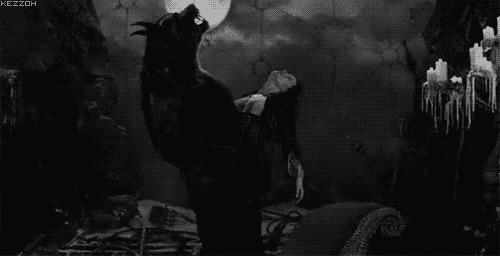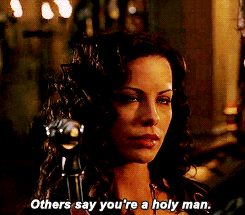It's a classic tale we all know. The buff and daring male lead is assigned to yet another mission, one that will take him into the face of danger and the arms of the sexy and flawless female who's name no one can seem to remember. They fall in love while escaping the imminent threat of danger and set out to destroy the source of evil that plagues them. Add in vampires, werewolves and Frankenstein, and what do you get? The thriller fantasy flick, Van Helsing.
Hugh Jackman plays the monster slayer, Van Helsing who travels to Transylvania to assist Anna Valerious (Kate Beckinsale) in the destruction of Dracula and his plan to bring his vampire offspring to life. Anna's entire family has been slaughtered in the fight against the Count, and Anna is the last living member. They team together in order to defeat a common enemy, and fall for each other along the way.
 Anna's first appearance shows her in the process of trapping a werewolf. Shown to the right is Anna's introductory shot, panning up her body as it display the curves of her figure. Anna is dressed somewhat appropriately, adorning tight black pants,thigh high lace up boots, a corset,and a loose white shirt. Compared to other female appearances in the film, Anna's costume is highly sexualized. This is normal for female characters within the genre to be dressed abnormally in comparison to other characters. Van Helsing also sticks to the gender roles that he assigned. Dressed in all dark, bulky and heavy clothing accompanied by his hat that shadows his face,Van Helsings' image is that of a
Anna's first appearance shows her in the process of trapping a werewolf. Shown to the right is Anna's introductory shot, panning up her body as it display the curves of her figure. Anna is dressed somewhat appropriately, adorning tight black pants,thigh high lace up boots, a corset,and a loose white shirt. Compared to other female appearances in the film, Anna's costume is highly sexualized. This is normal for female characters within the genre to be dressed abnormally in comparison to other characters. Van Helsing also sticks to the gender roles that he assigned. Dressed in all dark, bulky and heavy clothing accompanied by his hat that shadows his face,Van Helsings' image is that of a
mysterious but powerful man.
From the moment Helsing and Anna meet there is suggested sexuality between them. Soon after they meet, the two are attacked by the three vampire brides. This is where the first suggestion of their intimate relationship surfaces. It is not often that we see movies where the male and female leads are untied and continue a platonic relationship through the entirety of the film. Van Helsing is no exception.
Anna is not the only female character that falls victim to the hyper-sexualizing tendencies of the movie making industry. The three "brides" of Dracula are the most bright and shiny objects of the movie. Apart from their exposed chests and stomachs, all of their movements drip with sexuality. It isn't unusual for there to be one or more characters that will beportrayed as the "sex appeal" of the movie.
Anna is not the only female character that falls victim to the hyper-sexualizing tendencies of the movie making industry. The three "brides" of Dracula are the most bright and shiny objects of the movie. Apart from their exposed chests and stomachs, all of their movements drip with sexuality. It isn't unusual for there to be one or more characters that will beportrayed as the "sex appeal" of the movie.
Van Helsing abides by the successful formula of the many horror flicks before it. Together, the male and female lead defeat the villain. However, the female does not escape unscathed. As a result of Anna's attempt to inject the cure into Van Helsing, he unintentionally kills her. Van Helsing is ultimately cured, but at the cost of Anna's death. All ends well because the life threatening issue has been rectified by none other than the male lead. Although Van Helsing does paint Anna as a powerful young huntress, this film does not break free of any standard gender representations.
For those that are familiar with Bram Stoker's Dracula, it is hard to recognize any similarities between the two stories. In Stoker's Dracula, Dracula is an all powerful monster that preys on helpless women with the intention of one day infecting the human race with the curse of the undead. Battling against a team of modern day civilians, Dracula kills as he pleases. The film Van Helsing has seemed to only borrow characters from the original story. Van Helsing does not even function as a prequel to Dracula, it is a complete spin off with hardly any connection to the original script.
The only lasting influence of this movie that seemed to stick with me was the the further portrayal of vampires as super sexual beings. The themes of female weakness and dependence were not as strong in this film, for which I was thankful. I found the movie to be predictable and hilariously over exaggerated, but I do not deny that it was entertaining.





I've never seen this movie, but I can see through all of your visuals how sexualized the main female character is. It seems like Van Helsing is portrayed differently in the film than in Stoker's novel version of Dracula. There is no denying how absolutely stunning Anna is, but I was glad to see that you noted that female weakness and dependency was not as strong in the film as the book.
ReplyDeleteGreat intro! Very creative. It pulled me into your piece right off the bat. I think you're a very colorful writer and the whole piece was interesting to read.
ReplyDeleteOverall I think you did a wonderful job in your summary of the movie and in pointing out the gender roles in this film. As I read, through, there seemed to me that there was some sarcasm in your writing, especially when you would discuss the female characters. As if you were trying to say "Well, here's another overly sexualized female character being used as something for the guys to look at!"
Overall I really enjoyed your post. I feel like you took the assignment quite seriously without taking the movie too seriously and that made your whole piece quite entertaining. Great job!